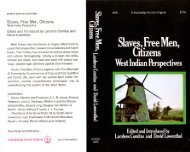e - CIFAS
e - CIFAS
e - CIFAS
You also want an ePaper? Increase the reach of your titles
YUMPU automatically turns print PDFs into web optimized ePapers that Google loves.
a<br />
GOVERNMENT IN ZAZZAU<br />
an average density of 60 per square mile, but this density varied<br />
widely throughout the area. However, with such a relatively low<br />
over-all population density, arable land has little commercial value,<br />
except on the immediate outskirts of the large settlements. With<br />
this: low population density we find a system of land tenure under<br />
which rights of use and occupancy now have priority over other<br />
rights of ownership.l In pre-British days the rulers of Zaria<br />
sought to increase this population by acquiring slaves for £ann<br />
production. Of the present population of the Kingdom, about 60<br />
per cent. are Muhammadan Hausa and Fulani, while the rest are<br />
members of some thirty or more tribes who are distinguished as<br />
'pagans' (arna) from the surrounding Muslims and Christians.<br />
Excluding the few settlements of non-Islamized Hausa lmown as<br />
Maguzawa in Northern Zaria, the entire pagan population occu~<br />
pies areas in the southern and western half of the territory which<br />
has heavier rainfall and denser woodland than the more open and<br />
cloee1y 8ettled north peopled by Muhammadans. Throughout this<br />
area of predominantly pagan population the Hausa are found in<br />
enclaves, walled towns, or open viUages, which are the foci of<br />
eoonomic, political, and administrative life in their respective<br />
areas. Some of these Hausa enclaves are centuries old, others are<br />
of recent foundation. Throughout the territory one also encounters<br />
cattle-camps in the bush where the nomad Fulani<br />
pastoralists tend their large-horned herds in the course of<br />
migratory cycles which follow the movement of the seasons and<br />
8eCk to avoid the tsetse fly."<br />
This large area and variegated population is: now administered<br />
as a single unit under the Fulani Sarnn Zazzau (ruler ofZaria, or<br />
Emir, in the language of the Nigerian Government). Until 1950<br />
he was directly responsible to the Government of Nigeria through<br />
the senior local officers ofthe British Administration. the Resident,<br />
and the Divisional Officer. ~<br />
Before the British established their rule in Northern Nigeria<br />
the beginning of this century, the Fulani had ruled Zaria by .<br />
of conquest for almost a hundred years; and before the ~, .<br />
conquest Zaria was a Habe kingdom, the southernmost of Seven<br />
independent but closely related Rausa states, whose origins are<br />
lost in antiquity.<br />
For present purposes three critical events may be regarded Il8<br />
1 See Cole, 1949- I See Stenning, )9.5'1 and )959.<br />
INTRODUCTION 3<br />
roarking eras in the development of Zazzau: (I) the introduction<br />
',of Islam, c. 14561; (2) the conquest of Zaria by the Fulani in 1804;<br />
':.(3) the incorporation of Zaria into the Protectorate of Northern<br />
'Nigeria by Lugard in 1900. A fourth era began in 1951 with the<br />
~'promulgationof the Macpherson constitution for the federation of<br />
Nigeria, and with the development of responsible government<br />
based on elections. However, as our study will not be concerned<br />
with developments after 1950, no discussion of this new constitution<br />
and its consequences will be attempted here.<br />
Islamic influences reached Zaria, the capital of Zazzau, from the<br />
north by way of the Habe states of Kano and Katsina, to which<br />
also came camel caravans with salt and other products from the<br />
Sahara and beyond, returning with grain, slaves, leather, cloth.<br />
etc. In view of the number of pagan Hahe kings who ruled at<br />
{ Zaria between 1486 and 180{. when the Fulani expelled the Habe<br />
dynasty, it seems that Islamic prose1ytization at first made slow<br />
headway in Zazzau. At this period the principal bond8 between the<br />
seven Habe kingdoms, including Zazzau, and the more thoroughly<br />
Is1amized populations of the Western Sudan, were commercial<br />
and political rather than religious. But eventuaUy, in the early<br />
nineteenth century, peaceful proselytization gave way to force.<br />
Nomadic, semi-nomadic, and settled Fulani groups differing<br />
6harply from the sedentary Hausa in physical and cultural features,<br />
and led by a group of militant Fulani mallams (religious leaders<br />
and Islamic scholars), then conquered all the Hausa 8tates in<br />
turn, beginning with Daura, the oldest; these Habe kingdoms<br />
were then incorporated into an expanding Fulani empire under<br />
the leadership and control ofOthman Dan Fodio, the Fulani leader<br />
who was thereafter known as the Sarkin Musulmi (Chief of the<br />
M..lim8).<br />
When the Fulani attacked Zazzau in 1804> the reigning Habe<br />
king, Makau, fled southwards with certain followers to Zuba, and<br />
managed to resist Fulani attacks from that place. Makau's successors<br />
consolidated their position and established an independent<br />
Habe state later known as Ahuja in this area, the population of<br />
which had previously owed allegiance to them as rulers of Zazzau.<br />
This Habe kingdom 8urvived until the arrival of the British,<br />
despite severe Fulani attacks, and the kings of Ahuja to this day<br />
8tyle themselves 'rulers of Zazzau', adhering to the distinctive<br />
! Arnett, (909.





